George Stubbs : artiste peintre et anatomiste.
LE FORUM DE MARIE-ANTOINETTE :: La France et le Monde au XVIIIe siècle :: Les Arts et l'artisanat au XVIIIe siècle :: Les arts graphiques et la sculpture
Page 1 sur 1
 George Stubbs : artiste peintre et anatomiste.
George Stubbs : artiste peintre et anatomiste.
C'est l'annonce d'une exposition consacré à cet artiste, que je ne connaissais pas, qui m'a donné l'idée d'ouvrir ce sujet de présentation... 

 Infos complémentaires : Palace House - The Moller Gallery
Infos complémentaires : Palace House - The Moller Gallery
 Je cite la fiche Wikipedia (extraits) qui lui est consacrée, et illustre à mon goût...
Je cite la fiche Wikipedia (extraits) qui lui est consacrée, et illustre à mon goût... 
George Stubbs (1724 - 1806)

George Stubbs
After Ozias Humphry
watercolour and pencil, 1777-1779
Image : National Portrait Gallery, London
George Stubbs, né le 25 août 1724 à Liverpool, mort le 10 juillet 1806 à Londres, est un peintre et un graveur animalier anglais du XVIIIe siècle. Surnommé « le peintre des chevaux », Stubbs est un artiste très apprécié pour son sens de l'observation et du détail.
Ses peintures de chevaux sont renommées, et cela grâce à sa parfaite connaissance de la morphologie du cheval, due entre autres aux dissections qu'il a effectuées pendant près de 18 mois, et dont il tira un traité.
Biographie :
Stubbs est né à Liverpool, fils d'un marchand de cuir. Ses débuts sont peu connus au moins jusqu'à l'âge de trente-cinq ans, et reprennent essentiellement les notes faites par l'artiste Ozias Humphry juste avant la mort de l'artiste.
Il travailla jusqu'à l'âge de quinze ans dans le commerce familial puis à la mort de son père en 1741, il fut brièvement apprenti chez Hamlet Winstanley, peintre et graveur dans le Lancashire qu'il quitta rapidement à cause de sa tâche de copiste.
Vers la fin des années 1740, il devint portraitiste dans le nord de l'Angleterre en étudiant en parallèle l'anatomie au York County Hospital (entre 1745 et 1751).
Depuis son plus jeune âge, il était passionné d'anatomie et l'un de ses premiers travaux fut un recueil d'illustrations sur l'accouchement pour un ouvrage du docteur John Burton (1701-1771), Essay Towards a Complete New System of Midwifery en 1751.

An essay towards a complete new system of midwifry, theoretical and practical.
Together with the descriptions, causes and methods of removing, or relieving the disorders peculiar to pregnant ... women, and new-born infants.
By John Burton. Illustrations by George Stubbs. Table 13.
En 1754, Stubbs voyage en Italie pour « se convaincre lui-même que la nature était et est toujours supérieur à l'art grec ou romain, et renforçant sa conviction, il décida de retourner chez lui » (Notes d'Ozias Humphry).
En 1756, il loue une ferme dans le village de Horkstow dans le Lincolnshire et passe 18 mois à disséquer des chevaux, aidé par sa femme, Mary Spencer.
Il déménage à Londres vers 1759 et en 1766 publie The anatomy of the Horse, dont les dessins originaux se trouvent maintenant dans les collections de la Royal Academy.

Muscles, bones and blood-vessels of a horse: an écorché figure, side view.
Engraving with etching by G. Stubbs, 1766. Plate to: G. Stubbs, The anatomy of the horse..., published for the author, London, 1766, reprinted 1815
Image : Wellcome Collection Galery / Wikipedia

George Stubbs. The Anatomy of the Horse. London 1766, Vol 4. Plate 18
Image : Warburg 1866 / Wikipedia
Avant même la parution de cet ouvrage et grâce à sa parfaite connaissance de la morphologie du cheval, ses dessins étaient vu par l'aristocratie de l'époque comme les plus précis parmi ceux de ses contemporains comme James Seymour, Peter Tillemans et John Wootton.

Mares and Foals in a River Landscape
Georges Stubbs
Oil on canvas, c. 1763-68
Image : Tate Britain - Creative Commons CC-BY-NC-ND

George Stubbs, A.R.A. (Liverpool 1724-1806 London)
James Hamilton, 2nd Earl of Clanbrassil (1730-1798), with his bay hunter Mowbray, resting on a wooded path by a lake
Oil on canvas, signed and dated 'Geo Stubbs / pinxit / 1765' (lower right
Image : Christie’s

Tristram Shandy, a bay racehorse held by a groom, in an extensive landscape
George Stubbs (1724-1806)
signed 'Geo: Stubbs Pinx.' (lower left)
oil on canvas
Image : Christie’s

Horse Frightened by a Lion
George Stubbs
Oil on canvas, between 1762 and 1768
Image : Yale Center for British Art, Paul Mellon Collection – Google Art Project

The Marquess of Rockingham's Arabian Stallion (led by a Groom at Creswell Crags)
George Stubb
Oil on canvas, about 1780
Image : Scottish National Gallery / Google Art Culture
En 1759, le 3e duc de Richmond lui demanda trois grands tableaux lui assurant ainsi sa carrière.
Grâce à plusieurs autres commandes, en 1763, il s'acheta une maison dans le quartier de Marylebone où il vécut le restant de ses jours.
Son tableau le plus fameux est certainement Whistlejacket, peinture d'un cheval cabré commandé par la marquise de Rockingham, qui se trouve maintenant à la National Gallery de Londres.
Cette peinture rompt la norme avec un arrière-plan uniforme.

Whistlejacket
George Stubbs
Oil on canvas, about 1762
Image : The National Gallery, London
Pendant les années 1760, il produisit un grand nombre de tableaux de chevaux, parfois accompagnés de chiens ou alors de leur valet d'écurie.

The Third Duke of Dorset's Hunter with a Groom and a Dog
George Stubbs
Oil on canvas, 1768
Signed and dated (lower right): Geo. Stubbs / pinxit. 1768
Image : The Metropolitan Museum of Art

Hambletonian, Rubbing Down
George Stubbs
Oil on canvas, c. 1799
Image : The National Trust Collection

Phaeton with a Pair of Cream Ponies and a Stable-Lad
George Stubbs
Oil on canvas, between 1780-1784
Image : Yale Center for British Art, Paul Mellon Collection
Il peignit aussi des animaux exotiques comme des lions, tigres, girafes, singes et rhinocéros qu'il pouvait observer dans les ménageries privées.
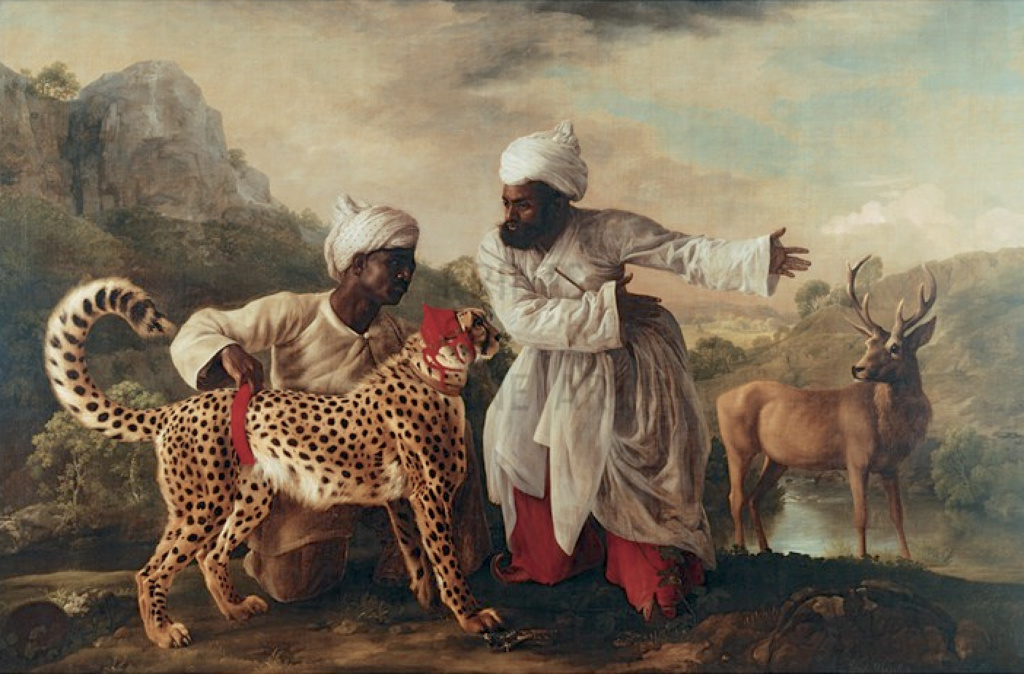
Cheetah And Stag With Two Indians
By George Stubbs
Oil on canvas, c. 1765
Image : Prints and FineArt

A Zebra
George Stubbs
Oil on canvas, 1763
Image : Yale Center for British Art, Paul Mellon Collection – Google Art Project

The Kongouro from New Holland (Kangaroo)
by George Stubbs
Oil on canvas, 1772
Image : National Maritime Museum, Greenwich, London.

A monkey
George Stubbs
Oil on panel, 1799
Image : Walker Art Gallery, Liverpool

Two Leopards
by George Stubbs
oil on oak panel, c. 1776
Image : ArtDaily.com / Wikipedia
Il continua de faire des portraits de personnes. Il exposa ses toiles à la « Society of Artists » jusqu'en 1775 puis à la toute nouvelle Royal Academy, plus prestigieuse. Stubbs fit aussi quelques tableaux historiques.

Newmarket Heath, with a Rubbing-Down House
Oil on canvas, c.1765
Image : Tate Britain - Creative Commons CC-BY-NC-ND
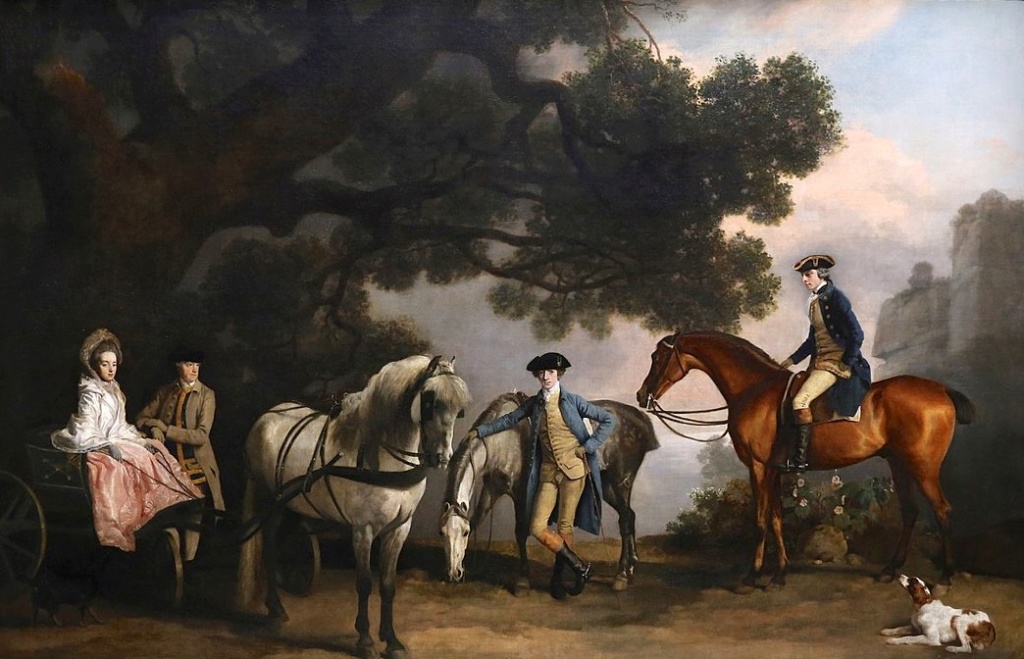
The Milbanke and Melbourne Families
George Stubbs
Oil on canvas, about 1769
The National Gallery, London
Image : Sailko / Wikipedia

The Countess of Coningsby in the Costume of the Charlton Hunt
Oil on canvas, c. 1760
Image : Yale Center for British Art, Paul Mellon Collection – Google Art Project
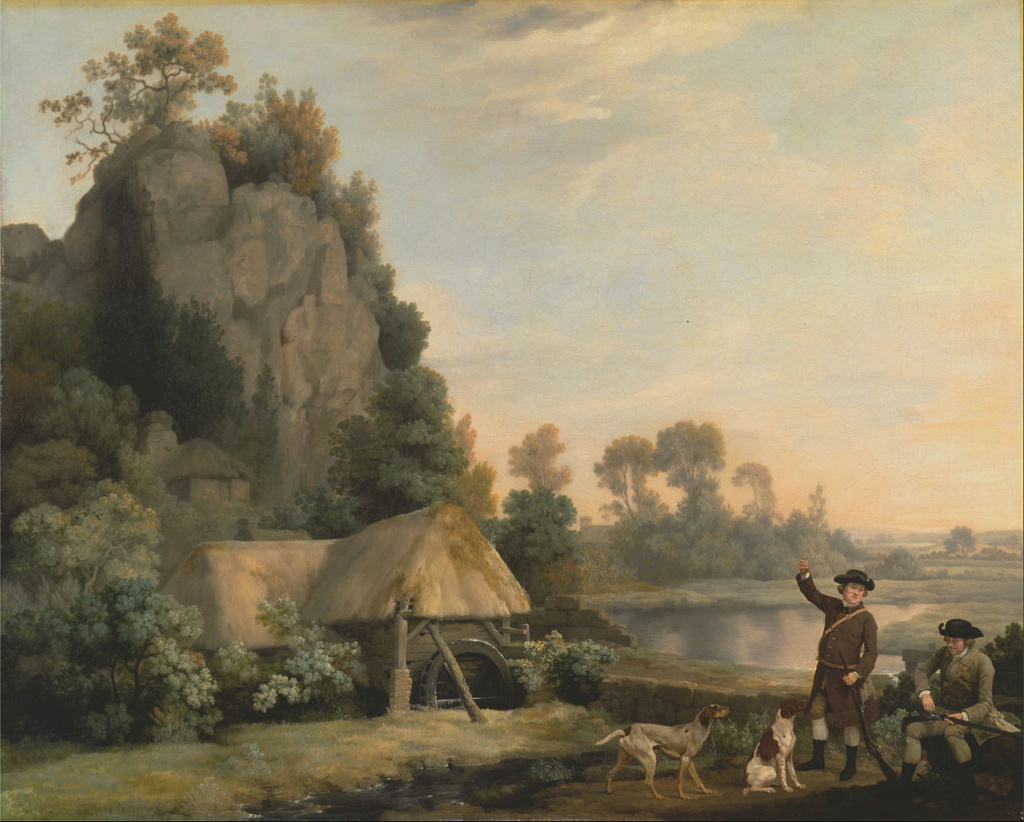
Two Gentlemen Going a Shooting, with a View of Creswell Crags, Taken on the Spot
George Stubbs
Oil on canvas, c. 1767
Image : Yale Center for British Art, Paul Mellon Collection - Google Art Project
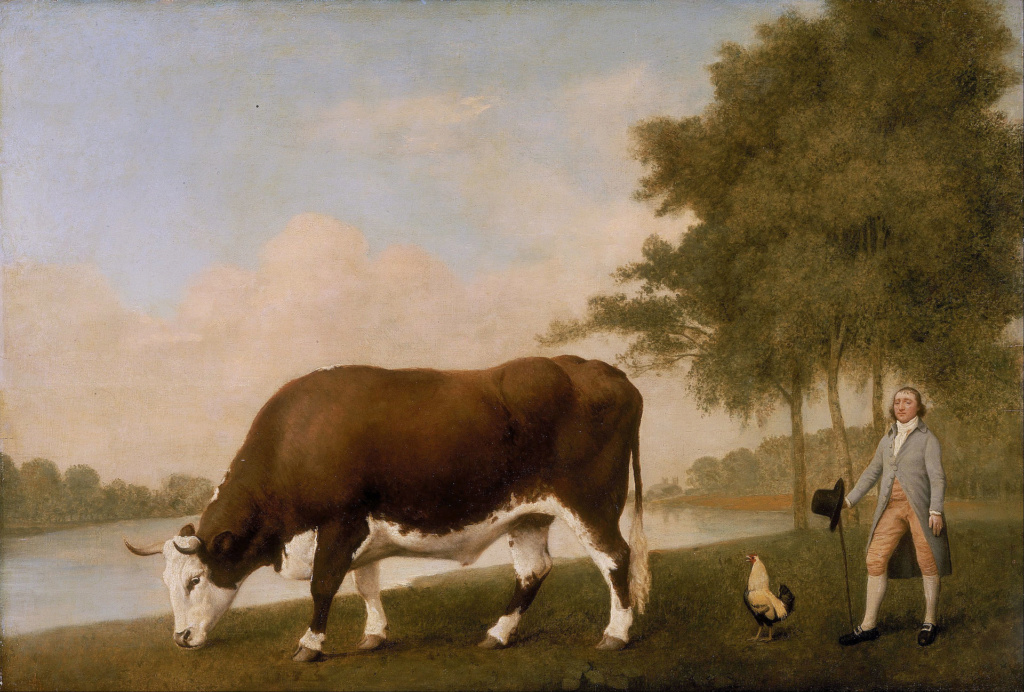
The Lincolnshire Ox
George Stubbs
Oil on canvas, 1790
Image : Liverpool Museum - Google Art Project
Oeuvre :
À la fin des années 1760, il produit quelques émaux grâce à sa collaboration avec Josiah Wedgwood qui produisit un nouveau type d'émaux. Mais cela fut un échec d'un point de vue financier.

Wedgwood Family Portrait
George Stubbs
Oil on canvas, 1780
Image : Art Fund – The Wedgwood Collection Highlights
In the summer of 1780 George Stubbs stayed with the Wedgwood family at Eturia Hall, while Josiah worked on creating terracotta plaques that the artist would be able to paint on. These large-size pieces incurred a great production cost, so Josiah suggested Stubbs made 'payment in painting' with a picture of the family gathered in the grounds of their home.
Unfortunately the piece was not liked by Josiah, who felt that the likenesses were ‘strong, but not very delicate’ and was particularly critical of the depictions of his wife Sarah, and their daughters Susannah and Mary Anne. Although never fully satisfied with the result, Josiah finally admitted that there was ‘much to praise and little to blame’ in the Stubbs painting.

Horse Frightened by a Lion (Episode A),"
By the English potter and sculptor Josiah Wedgwood and Thomas Bentley, after George Stubbs.
Modeled in 1780.
Solid blue jasper with white relief, shallow oval.
Image : Courtesy of the Paul Mellon Collection, Yale Center for British Art, Yale University, New Haven, Connecticut / Wikipedia

Phaeton
Benjamin Green, after George Stubb
Print, 1777
Image : Metropolitan Museum of Art
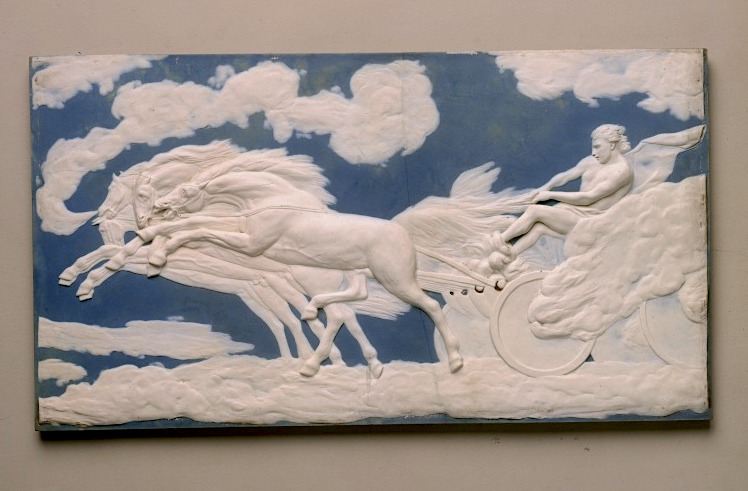
A blue jasper tablet depicting the Greek legend of the Fall of Phaethon after he is granted the opportunity to drive the Chariot of the Sun.
The tablet was modelled by the Liverpool artist George Stubbs (1724-1806).
He modelled it whilst staying with Wedgwood to paint a family portrait in 1780. Wedgwood disliked the design and only made a few of them in jasper.
Jasperware, Wedgwood, 1781-85
Collection : Lady Lever Art Gallery collections
Image : Liverpool Museums

Portrait of a Young Gentleman Out Shooting
George Stubbs
Enamel paint on Wedgwood biscuit earthenware, c. 1781
Image : Tate Britain - Creative Commons CC-BY-NC-ND
Il retourna donc à la peinture, avec des portraits de chiens ou des scènes de chasse avec des meutes.

Brown and White Norfolk or Water Spaniel,
George Stubbs
Beeswax and oil on panel, 1778
Image : after treatment, recto, unframed, cropped to image / Yale Center for British Art, Paul Mellon Collection

A Repose after Shooting
George Stubbs
Oil on canvas, 1770
Image : Yale Center for British Art, Given by Paul Mellon in memory of his friend James Cox Brady, Yale College, Class of 1929
cropped to image, recto, unframed
Puis dans les années 1780, il peignit quelques paysages, série appelée « Haymakers and Reapers », puis en 1790, le prince de Galles devint son mécène et il fit son portrait à cheval en 1791.

The Prince of Wales's Phaeton
George Stubbs
Oil on canvas, 1793
Acquired by George IV when Prince of Wales
Image : The Royal Collection Trust, HM Queen Elizabeth II 2012

Soldiers of the 10th Light Dragoons
George Stubbs
Oil on canvas, 1793
acquired by George IV when Prince of Wales
Image : The Royal Collection Trust, HM Queen Elizabeth II 2012

Laetitia, Lady Lade
George Stubbs
Oil on canvas, 1793
acquired by George IV when Prince of Wales
Image : The Royal Collection Trust, HM Queen Elizabeth II 2012

Haymakers
George Stubbs
Oil paint on wood, 1785
Image : Tate Britain - Creative Commons CC-BY-NC-ND
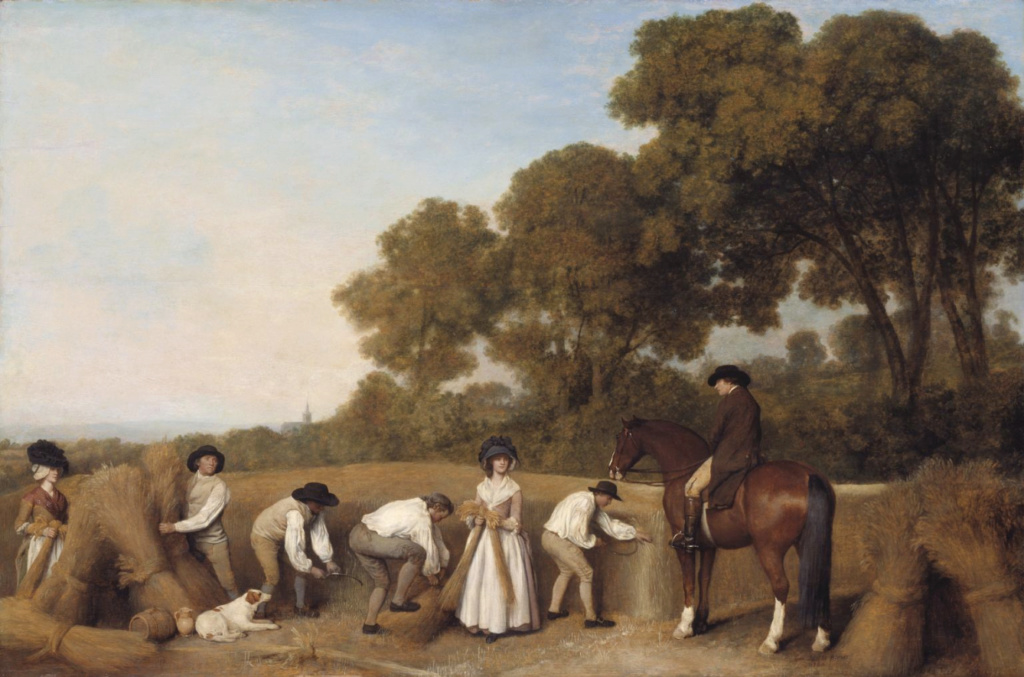
Reapers
George Stubbs
Oil paint on wood, 1785
Image : Tate Britain - Creative Commons CC-BY-NC-ND
Son dernier projet, commencé en 1795, fut une exposition anatomique comparant la structure du corps humain avec celle d'un tigre et d'une poule, 15 gravures parurent entre 1804 et 1806.
Le projet fut laissé inachevé à la mort de l'artiste le 10 juillet 1806 à Londres.

A Comparative Anatomical Exposition of the Structure of the Human Body with that of a Tiger and a Common Fowl : Human Skeleton (in Crawling Posture ; finished study for an unpublished table)
George Stubbs
Drawing, 1795 to 1806
Image : Yale, The Paul Mellon Centre for Studies in British Art

Tiger Body, Lateral view (Study of the muscles exposed at the third stage of dissection)
George Stubbs
Between 1795 to 1806,
Graphite and red chalk on thin, slightly textured, cream wove paper; squared in graphite for transfer
Image : Yale Center for British Art, Paul Mellon Collection

Fowl Skeleton, Lateral View (Finished Study for Table V)
George Stubbs
Between 1795 and 1806
Graphite on moderately thick, slightly textured, cream wove paper
Image : Yale Center for British Art, Paul Mellon Collection
* Source texte : Wikipedia - George Stubbs

_______________

George Stubbs (1724 - 1806)

George Stubbs
After Ozias Humphry
watercolour and pencil, 1777-1779
Image : National Portrait Gallery, London
George Stubbs, né le 25 août 1724 à Liverpool, mort le 10 juillet 1806 à Londres, est un peintre et un graveur animalier anglais du XVIIIe siècle. Surnommé « le peintre des chevaux », Stubbs est un artiste très apprécié pour son sens de l'observation et du détail.
Ses peintures de chevaux sont renommées, et cela grâce à sa parfaite connaissance de la morphologie du cheval, due entre autres aux dissections qu'il a effectuées pendant près de 18 mois, et dont il tira un traité.
Biographie :
Stubbs est né à Liverpool, fils d'un marchand de cuir. Ses débuts sont peu connus au moins jusqu'à l'âge de trente-cinq ans, et reprennent essentiellement les notes faites par l'artiste Ozias Humphry juste avant la mort de l'artiste.
Il travailla jusqu'à l'âge de quinze ans dans le commerce familial puis à la mort de son père en 1741, il fut brièvement apprenti chez Hamlet Winstanley, peintre et graveur dans le Lancashire qu'il quitta rapidement à cause de sa tâche de copiste.
Vers la fin des années 1740, il devint portraitiste dans le nord de l'Angleterre en étudiant en parallèle l'anatomie au York County Hospital (entre 1745 et 1751).
Depuis son plus jeune âge, il était passionné d'anatomie et l'un de ses premiers travaux fut un recueil d'illustrations sur l'accouchement pour un ouvrage du docteur John Burton (1701-1771), Essay Towards a Complete New System of Midwifery en 1751.

An essay towards a complete new system of midwifry, theoretical and practical.
Together with the descriptions, causes and methods of removing, or relieving the disorders peculiar to pregnant ... women, and new-born infants.
By John Burton. Illustrations by George Stubbs. Table 13.
En 1754, Stubbs voyage en Italie pour « se convaincre lui-même que la nature était et est toujours supérieur à l'art grec ou romain, et renforçant sa conviction, il décida de retourner chez lui » (Notes d'Ozias Humphry).
En 1756, il loue une ferme dans le village de Horkstow dans le Lincolnshire et passe 18 mois à disséquer des chevaux, aidé par sa femme, Mary Spencer.

Il déménage à Londres vers 1759 et en 1766 publie The anatomy of the Horse, dont les dessins originaux se trouvent maintenant dans les collections de la Royal Academy.

Muscles, bones and blood-vessels of a horse: an écorché figure, side view.
Engraving with etching by G. Stubbs, 1766. Plate to: G. Stubbs, The anatomy of the horse..., published for the author, London, 1766, reprinted 1815
Image : Wellcome Collection Galery / Wikipedia

George Stubbs. The Anatomy of the Horse. London 1766, Vol 4. Plate 18
Image : Warburg 1866 / Wikipedia
Avant même la parution de cet ouvrage et grâce à sa parfaite connaissance de la morphologie du cheval, ses dessins étaient vu par l'aristocratie de l'époque comme les plus précis parmi ceux de ses contemporains comme James Seymour, Peter Tillemans et John Wootton.

Mares and Foals in a River Landscape
Georges Stubbs
Oil on canvas, c. 1763-68
Image : Tate Britain - Creative Commons CC-BY-NC-ND

George Stubbs, A.R.A. (Liverpool 1724-1806 London)
James Hamilton, 2nd Earl of Clanbrassil (1730-1798), with his bay hunter Mowbray, resting on a wooded path by a lake
Oil on canvas, signed and dated 'Geo Stubbs / pinxit / 1765' (lower right
Image : Christie’s

Tristram Shandy, a bay racehorse held by a groom, in an extensive landscape
George Stubbs (1724-1806)
signed 'Geo: Stubbs Pinx.' (lower left)
oil on canvas
Image : Christie’s

Horse Frightened by a Lion
George Stubbs
Oil on canvas, between 1762 and 1768
Image : Yale Center for British Art, Paul Mellon Collection – Google Art Project

The Marquess of Rockingham's Arabian Stallion (led by a Groom at Creswell Crags)
George Stubb
Oil on canvas, about 1780
Image : Scottish National Gallery / Google Art Culture
En 1759, le 3e duc de Richmond lui demanda trois grands tableaux lui assurant ainsi sa carrière.
Grâce à plusieurs autres commandes, en 1763, il s'acheta une maison dans le quartier de Marylebone où il vécut le restant de ses jours.
Son tableau le plus fameux est certainement Whistlejacket, peinture d'un cheval cabré commandé par la marquise de Rockingham, qui se trouve maintenant à la National Gallery de Londres.
Cette peinture rompt la norme avec un arrière-plan uniforme.

Whistlejacket
George Stubbs
Oil on canvas, about 1762
Image : The National Gallery, London
Pendant les années 1760, il produisit un grand nombre de tableaux de chevaux, parfois accompagnés de chiens ou alors de leur valet d'écurie.

The Third Duke of Dorset's Hunter with a Groom and a Dog
George Stubbs
Oil on canvas, 1768
Signed and dated (lower right): Geo. Stubbs / pinxit. 1768
Image : The Metropolitan Museum of Art

Hambletonian, Rubbing Down
George Stubbs
Oil on canvas, c. 1799
Image : The National Trust Collection

Phaeton with a Pair of Cream Ponies and a Stable-Lad
George Stubbs
Oil on canvas, between 1780-1784
Image : Yale Center for British Art, Paul Mellon Collection
Il peignit aussi des animaux exotiques comme des lions, tigres, girafes, singes et rhinocéros qu'il pouvait observer dans les ménageries privées.

Cheetah And Stag With Two Indians
By George Stubbs
Oil on canvas, c. 1765
Image : Prints and FineArt

A Zebra
George Stubbs
Oil on canvas, 1763
Image : Yale Center for British Art, Paul Mellon Collection – Google Art Project

The Kongouro from New Holland (Kangaroo)
by George Stubbs
Oil on canvas, 1772
Image : National Maritime Museum, Greenwich, London.

A monkey
George Stubbs
Oil on panel, 1799
Image : Walker Art Gallery, Liverpool

Two Leopards
by George Stubbs
oil on oak panel, c. 1776
Image : ArtDaily.com / Wikipedia
Il continua de faire des portraits de personnes. Il exposa ses toiles à la « Society of Artists » jusqu'en 1775 puis à la toute nouvelle Royal Academy, plus prestigieuse. Stubbs fit aussi quelques tableaux historiques.

Newmarket Heath, with a Rubbing-Down House
Oil on canvas, c.1765
Image : Tate Britain - Creative Commons CC-BY-NC-ND

The Milbanke and Melbourne Families
George Stubbs
Oil on canvas, about 1769
The National Gallery, London
Image : Sailko / Wikipedia

The Countess of Coningsby in the Costume of the Charlton Hunt
Oil on canvas, c. 1760
Image : Yale Center for British Art, Paul Mellon Collection – Google Art Project

Two Gentlemen Going a Shooting, with a View of Creswell Crags, Taken on the Spot
George Stubbs
Oil on canvas, c. 1767
Image : Yale Center for British Art, Paul Mellon Collection - Google Art Project

The Lincolnshire Ox
George Stubbs
Oil on canvas, 1790
Image : Liverpool Museum - Google Art Project
Oeuvre :
À la fin des années 1760, il produit quelques émaux grâce à sa collaboration avec Josiah Wedgwood qui produisit un nouveau type d'émaux. Mais cela fut un échec d'un point de vue financier.

Wedgwood Family Portrait
George Stubbs
Oil on canvas, 1780
Image : Art Fund – The Wedgwood Collection Highlights
In the summer of 1780 George Stubbs stayed with the Wedgwood family at Eturia Hall, while Josiah worked on creating terracotta plaques that the artist would be able to paint on. These large-size pieces incurred a great production cost, so Josiah suggested Stubbs made 'payment in painting' with a picture of the family gathered in the grounds of their home.
Unfortunately the piece was not liked by Josiah, who felt that the likenesses were ‘strong, but not very delicate’ and was particularly critical of the depictions of his wife Sarah, and their daughters Susannah and Mary Anne. Although never fully satisfied with the result, Josiah finally admitted that there was ‘much to praise and little to blame’ in the Stubbs painting.

Horse Frightened by a Lion (Episode A),"
By the English potter and sculptor Josiah Wedgwood and Thomas Bentley, after George Stubbs.
Modeled in 1780.
Solid blue jasper with white relief, shallow oval.
Image : Courtesy of the Paul Mellon Collection, Yale Center for British Art, Yale University, New Haven, Connecticut / Wikipedia

Phaeton
Benjamin Green, after George Stubb
Print, 1777
Image : Metropolitan Museum of Art

A blue jasper tablet depicting the Greek legend of the Fall of Phaethon after he is granted the opportunity to drive the Chariot of the Sun.
The tablet was modelled by the Liverpool artist George Stubbs (1724-1806).
He modelled it whilst staying with Wedgwood to paint a family portrait in 1780. Wedgwood disliked the design and only made a few of them in jasper.
Jasperware, Wedgwood, 1781-85
Collection : Lady Lever Art Gallery collections
Image : Liverpool Museums

Portrait of a Young Gentleman Out Shooting
George Stubbs
Enamel paint on Wedgwood biscuit earthenware, c. 1781
Image : Tate Britain - Creative Commons CC-BY-NC-ND
Il retourna donc à la peinture, avec des portraits de chiens ou des scènes de chasse avec des meutes.

Brown and White Norfolk or Water Spaniel,
George Stubbs
Beeswax and oil on panel, 1778
Image : after treatment, recto, unframed, cropped to image / Yale Center for British Art, Paul Mellon Collection

A Repose after Shooting
George Stubbs
Oil on canvas, 1770
Image : Yale Center for British Art, Given by Paul Mellon in memory of his friend James Cox Brady, Yale College, Class of 1929
cropped to image, recto, unframed
Puis dans les années 1780, il peignit quelques paysages, série appelée « Haymakers and Reapers », puis en 1790, le prince de Galles devint son mécène et il fit son portrait à cheval en 1791.

The Prince of Wales's Phaeton
George Stubbs
Oil on canvas, 1793
Acquired by George IV when Prince of Wales
Image : The Royal Collection Trust, HM Queen Elizabeth II 2012

Soldiers of the 10th Light Dragoons
George Stubbs
Oil on canvas, 1793
acquired by George IV when Prince of Wales
Image : The Royal Collection Trust, HM Queen Elizabeth II 2012

Laetitia, Lady Lade
George Stubbs
Oil on canvas, 1793
acquired by George IV when Prince of Wales
Image : The Royal Collection Trust, HM Queen Elizabeth II 2012

Haymakers
George Stubbs
Oil paint on wood, 1785
Image : Tate Britain - Creative Commons CC-BY-NC-ND

Reapers
George Stubbs
Oil paint on wood, 1785
Image : Tate Britain - Creative Commons CC-BY-NC-ND
Son dernier projet, commencé en 1795, fut une exposition anatomique comparant la structure du corps humain avec celle d'un tigre et d'une poule, 15 gravures parurent entre 1804 et 1806.
Le projet fut laissé inachevé à la mort de l'artiste le 10 juillet 1806 à Londres.

A Comparative Anatomical Exposition of the Structure of the Human Body with that of a Tiger and a Common Fowl : Human Skeleton (in Crawling Posture ; finished study for an unpublished table)
George Stubbs
Drawing, 1795 to 1806
Image : Yale, The Paul Mellon Centre for Studies in British Art

Tiger Body, Lateral view (Study of the muscles exposed at the third stage of dissection)
George Stubbs
Between 1795 to 1806,
Graphite and red chalk on thin, slightly textured, cream wove paper; squared in graphite for transfer
Image : Yale Center for British Art, Paul Mellon Collection

Fowl Skeleton, Lateral View (Finished Study for Table V)
George Stubbs
Between 1795 and 1806
Graphite on moderately thick, slightly textured, cream wove paper
Image : Yale Center for British Art, Paul Mellon Collection
* Source texte : Wikipedia - George Stubbs
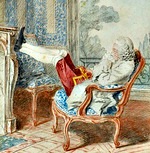
La nuit, la neige- Messages : 18135
Date d'inscription : 21/12/2013
 Sujets similaires
Sujets similaires» L'artiste peintre Marguerite Gérard
» La reine Marie Leszczynska, artiste peintre
» Joseph-Marie Vien, artiste peintre
» ZUKA artiste-peintre, et la Révolution française
» Joseph Bologne de Saint-George, dit le chevalier de Saint-George
» La reine Marie Leszczynska, artiste peintre
» Joseph-Marie Vien, artiste peintre
» ZUKA artiste-peintre, et la Révolution française
» Joseph Bologne de Saint-George, dit le chevalier de Saint-George
LE FORUM DE MARIE-ANTOINETTE :: La France et le Monde au XVIIIe siècle :: Les Arts et l'artisanat au XVIIIe siècle :: Les arts graphiques et la sculpture
Page 1 sur 1
Permission de ce forum:
Vous ne pouvez pas répondre aux sujets dans ce forum